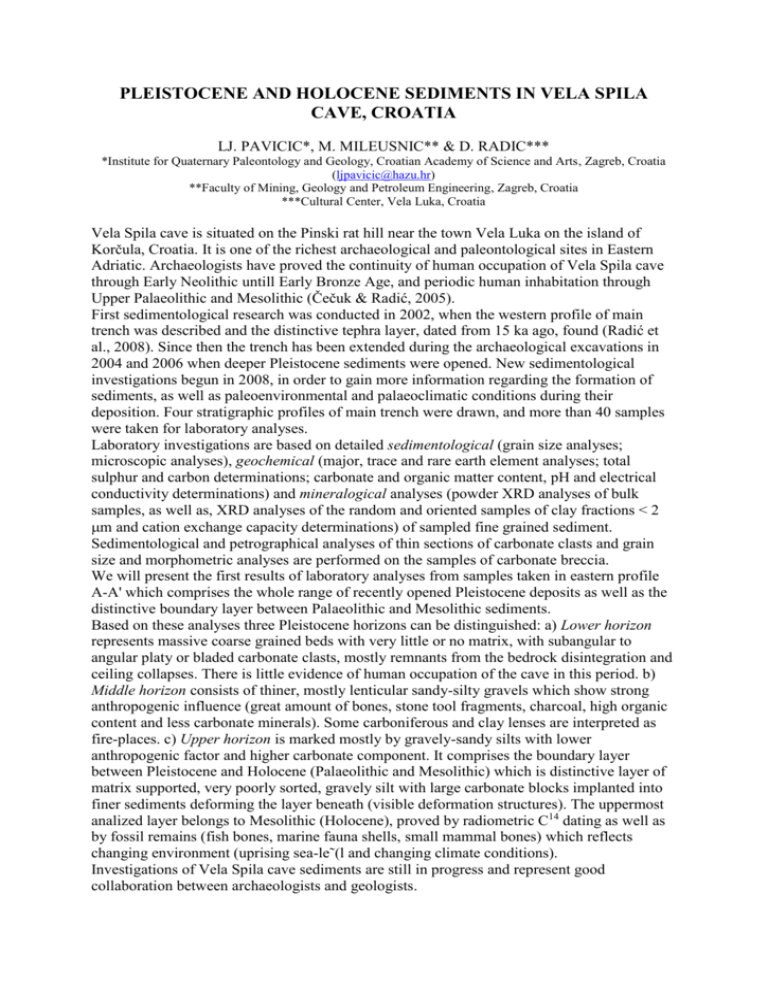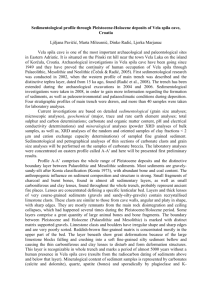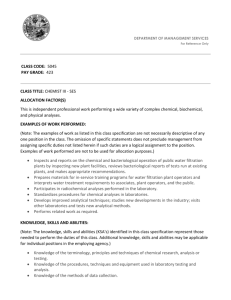pleistocene and holocene sediments in vela spila cave, croatia
advertisement

PLEISTOCENE AND HOLOCENE SEDIMENTS IN VELA SPILA CAVE, CROATIA LJ. PAVICIC*, M. MILEUSNIC** & D. RADIC*** *Institute for Quaternary Paleontology and Geology, Croatian Academy of Science and Arts, Zagreb, Croatia (ljpavicic@hazu.hr) **Faculty of Mining, Geology and Petroleum Engineering, Zagreb, Croatia ***Cultural Center, Vela Luka, Croatia Vela Spila cave is situated on the Pinski rat hill near the town Vela Luka on the island of Korčula, Croatia. It is one of the richest archaeological and paleontological sites in Eastern Adriatic. Archaeologists have proved the continuity of human occupation of Vela Spila cave through Early Neolithic untill Early Bronze Age, and periodic human inhabitation through Upper Palaeolithic and Mesolithic (Čečuk & Radić, 2005). First sedimentological research was conducted in 2002, when the western profile of main trench was described and the distinctive tephra layer, dated from 15 ka ago, found (Radić et al., 2008). Since then the trench has been extended during the archaeological excavations in 2004 and 2006 when deeper Pleistocene sediments were opened. New sedimentological investigations begun in 2008, in order to gain more information regarding the formation of sediments, as well as paleoenvironmental and palaeoclimatic conditions during their deposition. Four stratigraphic profiles of main trench were drawn, and more than 40 samples were taken for laboratory analyses. Laboratory investigations are based on detailed sedimentological (grain size analyses; microscopic analyses), geochemical (major, trace and rare earth element analyses; total sulphur and carbon determinations; carbonate and organic matter content, pH and electrical conductivity determinations) and mineralogical analyses (powder XRD analyses of bulk samples, as well as, XRD analyses of the random and oriented samples of clay fractions < 2 m and cation exchange capacity determinations) of sampled fine grained sediment. Sedimentological and petrographical analyses of thin sections of carbonate clasts and grain size and morphometric analyses are performed on the samples of carbonate breccia. We will present the first results of laboratory analyses from samples taken in eastern profile A-A' which comprises the whole range of recently opened Pleistocene deposits as well as the distinctive boundary layer between Palaeolithic and Mesolithic sediments. Based on these analyses three Pleistocene horizons can be distinguished: a) Lower horizon represents massive coarse grained beds with very little or no matrix, with subangular to angular platy or bladed carbonate clasts, mostly remnants from the bedrock disintegration and ceiling collapses. There is little evidence of human occupation of the cave in this period. b) Middle horizon consists of thiner, mostly lenticular sandy-silty gravels which show strong anthropogenic influence (great amount of bones, stone tool fragments, charcoal, high organic content and less carbonate minerals). Some carboniferous and clay lenses are interpreted as fire-places. c) Upper horizon is marked mostly by gravely-sandy silts with lower anthropogenic factor and higher carbonate component. It comprises the boundary layer between Pleistocene and Holocene (Palaeolithic and Mesolithic) which is distinctive layer of matrix supported, very poorly sorted, gravely silt with large carbonate blocks implanted into finer sediments deforming the layer beneath (visible deformation structures). The uppermost analized layer belongs to Mesolithic (Holocene), proved by radiometric C14 dating as well as by fossil remains (fish bones, marine fauna shells, small mammal bones) which reflects changing environment (uprising sea-le˜(l and changing climate conditions). Investigations of Vela Spila cave sediments are still in progress and represent good collaboration between archaeologists and geologists. Čečuk, B. & Radić, D. (2005): Vela spila. Višeslojno pretpovijesno nalazište Vela Luka – otok Korčula. Centar za kulturu „Vela Luka“. Vela Luka. p. 300. Radić, D., Lugović, B. & Marjanac, Lj. (2008): Napuljski žuti tuf (NYT) iz pleistocenskih naslaga u Veloj spili na Korčuli: dragocjeni marker prijelaza iz paleolitika u mezolitik. Opvsc. archeol., 31, 7-26.








